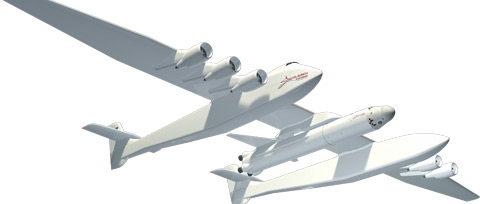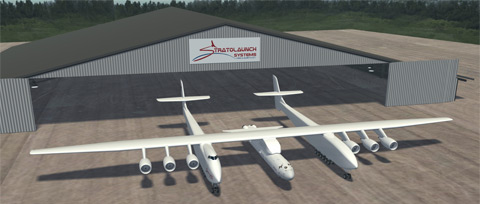
Tired of getting into orbit the same old way?
Relief may be coming from Stratolaunch Systems, a collaboration between Microsoft co-founder Paul Allen and Burt Rutan, the designer of aircraft and spacecraft, in a project that will merge a Rutan-inspired design with certain hardware and engines from Boeing 747s to create a huge airplane that will launch rockets into orbit during high altitude flight.
But don’t rush off and cancel your $200,000 reservation (booked through “your local accredited space agent”) for a suborbital flight on Richard Branson’s Virgin Galactic spaceline just yet.
Not because of any code-sharing arrangements, even though the two services will operate from the same spaceport in New Mexico. It’s more a matter of timing: There’s no hurry, with the Paul Allen craft not scheduled to make its first flight for five years, and with Branson’s project, based on a second-generation Scaled Composites design, also in early development (although taking bookings for passengers and scientific projects).
On both cases, the ventures demonstrate that private enterprise is forging ahead to fill the vacuum left when NASA’s space shuttle program ended several months ago.
On Dec. 13, Allen and Rutan announced that they had reunited via Huntsville, Ala.-based Stratolaunch Systems to “develop the next generation of space travel” after the 2004 flight of SpaceShipOne became the first flight of a manned, privately funded rocket flown beyond the atmosphere of the earth. They were accompanied at a Seattle, Wash., news conference by Stratolaunch board member and former NASA administrator Mike Griffin. The venture’s president and CEO is Gary Wentz, formerly a NASA chief engineer.
“I have long dreamed about taking the next big step in private space flight after the success of SpaceShipOne—to offer a flexible, orbital space delivery system,” Allen said. “We are at the dawn of radical change in the space launch industry. Stratolaunch Systems is pioneering an innovative solution that will revolutionize space travel.”
The product of Allen’s enterprise will be a mobile launch system that includes the carrier —the largest aircraft ever to have flown, Allen said—under development at Rutan’s company Scaled Composites; a multi-stage booster manufactured by Elon Musk’s Space Exploration Technologies (SpaceX); and “a state-of-the-art mating and integration system allowing the carrier aircraft to safely carry a booster weighing up to 490,000 pounds.” That component will be built by aerospace engineering firm Dynetics, said the announcement.
The craft will be powered by six Boeing 747 engines, and have a gross weight of more than 1.2 million pounds and a 380-foot-plus wingspan, requiring a 12,000-foot-long runway.
“The plane will be built in a Stratolaunch hangar which will soon be under construction at the Mojave (Calif.) Air and Space Port. It will be near where Scaled Composites built SpaceShipOne which won Allen and Scaled Composites the $10-million Ansari X Prize in 2004 after three successful sub-orbital flights,” it said.
Launching directly into orbit from high altitude “will mean lower costs, greater safety, and more flexibility and responsiveness than is possible today with ground-based systems,” the announcement said, adding that the capability of making quick turnarounds will “break the logjam of missions queued up for launch facilities and a chance at space.”
First will come unmanned payloads, with human flights to follow “after safety, reliability and operability are demonstrated,” the announcement said.




